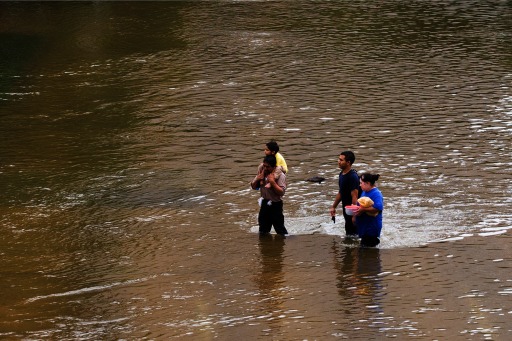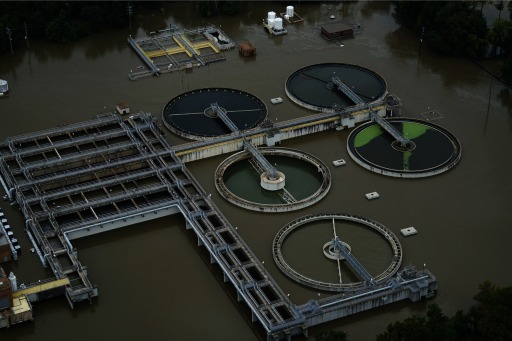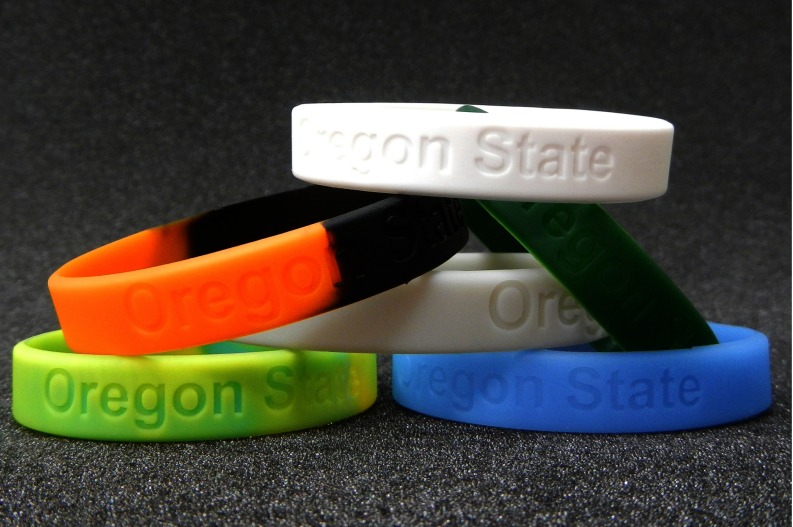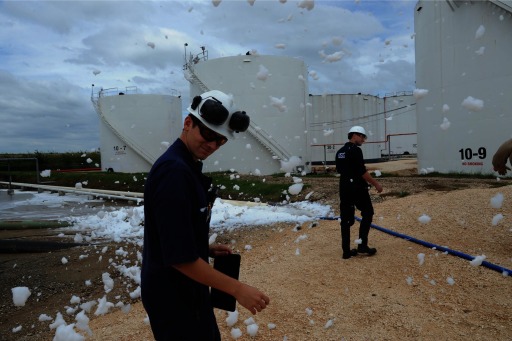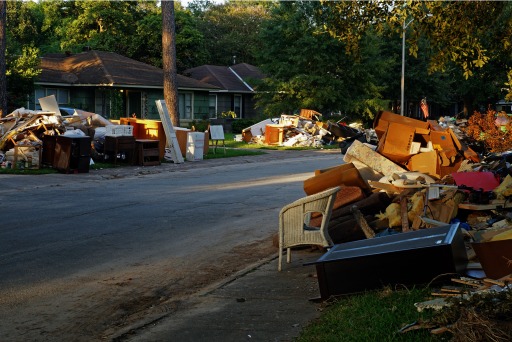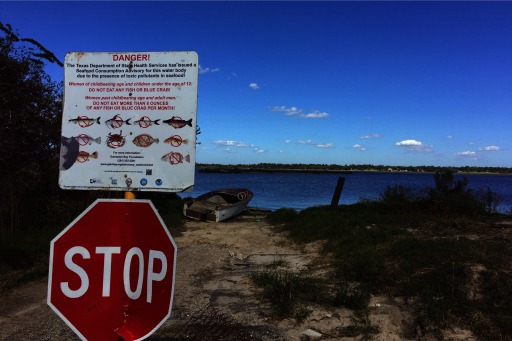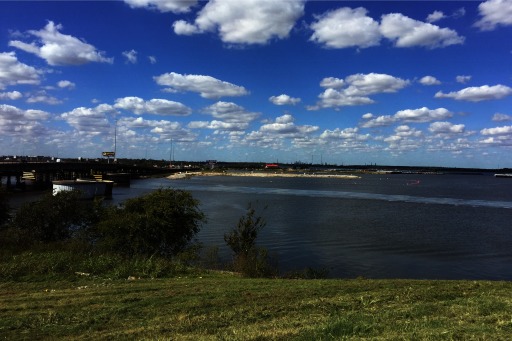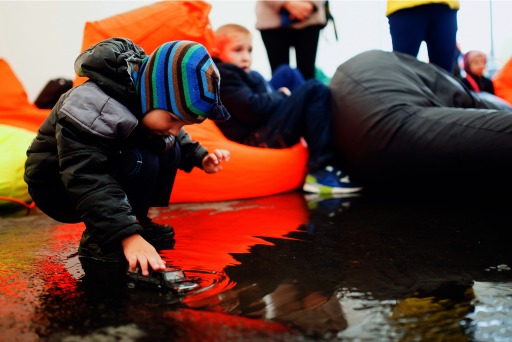Over the course of four days in August 2017, Hurricane Harvey dropped up to 61 inches of rain on parts of Greater Houston, an area larger than New Jersey.1 During the storm, dams reached peak levels, necessitating drawdowns that swamped downstream neighborhoods well beyond the 100-year floodplain.2 Across southeastern Texas more than 300,000 homes and 500,000 vehicles were reported flooded.1
The floodwaters that swirled through many of Houston’s streets contained arsenic, lead, and dangerously high levels of Escherichia coli, among other agents.3,4 Over a 13-county area, 46 chemical plants and refinery sites released a reported 4.6 million pounds of so-called “excess emissions” above and beyond normal operations—some due to necessary shutdown or startup procedures and others due to unforeseen leaks or explosions.5,6
Forty-three Superfund sites lay in the hurricane’s path;7 one of these was the San Jacinto River Waste Pits (SJRWP) site, which sustained damage that released dioxins into the surrounding area.8 A damaged tank at the Valero oil refinery leaked more than 235,000 pounds of benzene, toluene, and other volatile organic compounds.5 A short way outside of Houston, there were multiple explosions and finally a controlled burn at an Arkema facility that stored organic peroxides.9 Months after the storm, evidence emerged that the environmental impact of the storm far exceeded early reports.10
When Hurricane Harvey hit in August 2017, it brought catastrophic flooding to the Texas coast. According to the National Hurricane Center, the Houston area received the largest amount of rainwater from a single storm—almost 61 inches in some areas—ever recorded in the United States. Image: © michelmond/Shutterstock.
Many people waded through these contaminated floodwaters to reach shelter. While they waited in schools, churches, and civic centers, their flooded dwellings soaked in the collection of pathogens and toxics. Then came the laborious gutting and cleaning up of homes. Texas temporarily suspended its state regulations on household hazardous waste to allow quicker cleanup, and all the waste collected—carpets, furniture, electronics, household chemicals, and more—was piled at an abandoned landfill to be sorted out later.11,12 One county official in Port Arthur, about 90 miles east of Houston, called the heaps of debris “a deadly conglomerate, an incubator for bacterial growth, parasite multiplication, fungi generation, protozoan and rickettesial replication, rodent and other small animal infestation and flies breeding.”13
Days after Harvey departed, 37 drinking water systems across the disaster area were shut down, and 188 had issued boil-water notices.36 In addition, approximately 425 wastewater treatment plants were inoperable.36 Altogether, about 149 million gallons of untreated sewage and industrial wastewater was reportedly released as a result of the hurricane.37 Image: © DIIMSA Researcher/Shutterstock.
Two months after Hurricane Harvey raged, two Texas A&M University graduate students, Kahler Stone and Gaston Casillas, went to Manchester, a neighborhood in East Houston, to ask whether residents will wear a silicone wristband as part of a study on environmental exposures related to hurricane flooding. The silicone wristbands are a novel passive sampling device that can gather information on hundreds of chemicals to which people are exposed.
The study, led by Texas A&M associate professor of epidemiology Jennifer Horney, is funded by the National Institute of Environmental Health Sciences (NIEHS) Superfund Program, which established a new Texas A&M Superfund Research Center in 2017. Since 2016, Horney and her team have studied environmental exposures in 25 randomly selected homes in this neighborhood.
Manchester is a compact neighborhood, and its mostly low-income Hispanic residents live between a 24-line Union Pacific rail station, the Houston Ship Channel, the Interstate 610 bridge, and the sprawling Valero refinery. Before Hurricane Harvey even hit, the team had collected dust samples of all 16 polycyclic aromatic hydrocarbons (PAHs) on the U.S. Environmental Protection Agency (EPA) list of Priority Pollutants from the Manchester homes. Residents of Manchester and other marginalized communities in Houston have greater acute and chronic health risks than residents of neighborhoods located farther from the Houston Ship Channel.14 “They have a lot of potential environmental exposures,” Horney says of the residents.
As soon as the floodwaters subsided enough to reach the community, Horney’s team came back to Manchester, joining with local organizations to distribute supplies. They also collected sediment from the flooded yards of 24 of those homes to assess whether the hurricane had redistributed the PAHs detected earlier. Because the study participants in Manchester had already been participating in Horney’s exposure studies, they were interested in seeing how Harvey might have made matters worse—or not, as the case may be. The first paper from Horney’s post-hurricane work presented an approach to address the challenges inherent to studies conducted in the aftermath of a major disaster.15
Horney’s team is not the only one using silicone wristbands to study exposures related to Hurricane Harvey. In neighborhoods across Houston, researchers from other institutions have passed out the bracelets to assess people’s exposures. Ultimately such work will likely help inform public health officials, emergency responders, and community members about the special exposures they may face during and after flooding events.
Silicone Wristbands Repurposed
First made popular by Lance Armstrong’s yellow Livestrong bands, silicone wristbands have gained new popularity among public health specialists wanting to study individuals’ unique exposures. The wristbands are a low-cost, shelf-stable, easy-to-transport, and easy-to-store passive sampling device.
“There are active samplers where people wear a two-pound battery pack, and a fan pulls air over a solid phase [cartridge], and they wear it for two days,” says Kim Anderson, a professor and director of the Food Safety and Environmental Stewardship Program at Oregon State University (OSU). “But clearly it’s a lot easier to wear a wristband.”
After the hurricane, multiple teams of researchers fanned out across the besieged city of Houston. Their goal was to assess storm-related chemical exposures using silicone wristbands, a low-cost, easy-to-use passive sampling device. Image: © Holly Dixon/Oregon State University.
Anderson developed the idea of the silicone sampler a decade ago. She first experimented with a necklace sampler, which held the sensor in a pendant form. These did not go over well with men. Then she had an epiphany at an OSU football game. She noticed fans wearing silicone wristbands, which are made of a polymer that happens to be used in other passive sampling devices.16,17 What if those bracelets could be used to sample a person’s specific individual exposures over a certain time period?
Anderson bought some wristbands and got started. After working out the details of how to completely remove any preexisting chemical traces from the wristbands with solvents, her lab tested whether chemicals that they infused into the bands would degrade after time stored in a bag or outside in direct sun. They did not.
Next, the researchers ran a pilot study with 30 individuals who wore wristbands for 30 days to see how well the bands would absorb ambient chemicals. They identified 49 different chemicals, including compounds typically found in consumer and personal care products, pesticides, flame retardants, phthalates, flea repellants, and even caffeine.18 In the same pilot study, the team had eight roofers wear the wristbands during one day of work to test for exposures to PAHs, which are found in hot asphalt and roofing tar. They found the bands reflected individualized exposures even within this short time period.18
Since then, the wristbands have flourished in environmental science research. “Right now, we can test for 1,529 chemicals in one person’s wristband,” Anderson says.19,20 These include organic compounds but not metals or inorganic gases such as carbon monoxide or sulfur dioxide. They also cannot detect mold—a concern after flood events like Harvey.
Many researchers have begun collaborating with Anderson or are conducting their own independent projects. “We just haven’t even begun to scratch the surface,” she says. “I have studies on three different continents. … We’re looking at sensitive populations that probably wouldn’t be able to handle other sampling techniques. There are just lots and lots of applications.”
A Breakthrough Sampling Device
Porous silicone absorbs ambient chemicals in much the same way as a biological cell. “Our body and our skin … can act as passive samplers,” says Heather Stapleton, a Duke University associate professor of environmental health who has used the wristbands in her own research (unrelated to Hurricane Harvey). Like a real-life version of the “Peanuts” character Pig-Pen, she says, “we all have these particle clouds all around us. Any chemical in the air can adhere to [a wearable passive sampler].”
But not all the chemicals that are absorbed by silicone wristbands necessarily pass through our skin. “We might be exposed to certain chemicals by touching them or if they get onto our skin, but they may not be absorbed into our body, because our skin is a barrier for some chemicals,” says Stapleton. “There could be slow dermal penetration absorption into the bloodstream for some of these chemicals, but not all, which is why it is important to understand which chemicals [the wristbands] will work for and which they will not.”
Stapleton has an NIEHS research grant to study children’s exposures to mixtures of chemicals that are present in the home and the built environment. When she read Anderson’s first paper18 on using wristbands to measure exposures, she became interested in exploring their use to measure children’s exposures to chemical mixtures. But first, she wanted to test how well the wristbands reflect people’s internal exposures to chemicals in their immediate environments—starting with flame retardants, a main focus of her research program.
Forty people wore wristbands for five consecutive days, collected their urine during three of those mornings, and provided one hand wipe sample. Stapleton found associations between urinary metabolites of organophosphate flame retardants—which are thought to metabolize within hours21—and levels collected by the wristbands. The wristbands actually reflected urinary levels of metabolites more accurately than the hand wipes.19 “We were very excited to find that [all the exposure measures] were highly correlated, which suggested the wristbands do capture meaningful exposures,” she says.
Houston is a major hub of oil and chemical production, and Hurricane Harvey caused spills at several oil refineries, fuel terminals, and chemical plants.38 At the Kinder Morgan fuel storage terminal (shown), Coast Guard personnel spread a substance known as aqueous film-forming foam on spilled oil to prevent it from igniting. Image: U.S. Coast Guard.
She is now using the same experimental design to measure exposures to polybrominated diphenyl ether flame retardants. The preliminary results are promising. Her research project involved children between 3 and 6 years of age, who were given an extra band by the investigators to keep as a souvenir. “They were really receptive and really enjoyed wearing the wristbands,” says Stapleton. “I think it was fun for the kids to think of themselves as being involved in a science project.”
She says there are still a lot of questions about what the wristbands are really measuring, what exposure pathways they pick up, and where they will and will not work. It is still unknown how differences among chemicals’ physicochemical properties influence their ability to be absorbed by silicone rubber. “There are several research groups trying to work through those issues,” Stapleton says, “but the wristbands certainly have a lot of potential.”
In addition to being noninvasive, silicone wristbands have other advantages over blood or urine for sampling individual exposures. “Blood has a number of proteins and hormones and all these other endogenous materials, and if you want to take a blood sample and measure a flame retardant, you have to remove all those other chemicals,” Stapleton says. “It can be a very laborious process to take a blood sample [and] extract and purify it before you can actually analyze an extract on a mass spectrometer. But the silicone wristband likely will not be prone to all those interferences.”
Detecting Harvey’s Impacts
In Harvey’s wake, multiple research teams sprang into action. In the biggest Harvey wristband study, a team at Baylor College of Medicine (BCM) deployed wristbands in three communities around Houston that experienced different types of flooding. Addicks was flooded by the overflow of the adjacent Addicks reservoir, while Baytown and East Houston received rainfall-related flooding. The researchers recruited participants hand in hand with organizations already doing disaster recovery work in these communities—distributing water, cleaning supplies, personal protective gear, and the like. BCM researchers also gave out wristbands to university employees from all over the city whose homes had flooded.
Addicks is a wealthy community on the outskirts of Houston, whereas Baytown, which lies along Galveston Bay approximately a mile from the flooded SJRWP Superfund site, is mostly blue collar. In East Houston, a predominantly Hispanic, low-income community with some undocumented residents, some people returned to homes without fully remediating them because they feared they would be deported if they sought assistance, according to the researchers and local community members.22 But despite their concern, many residents agreed to participate in the study.
As people began reclaiming their homes and businesses, waste including carpets, furniture, electronics, household chemicals, and other items quickly piled up on curbs. One county official called the heaps of debris “a deadly conglomerate” of foul agents. Image: © IrinaK/Shutterstock.
“When the floods hit, of course we’re all dealing with the impacts of the flood on ourselves and our staff and our institutions,” says Cheryl Walker, director of the Center for Precision Environmental Health at BCM. But Harvey, as catastrophic as it was, provided the opportunity for a natural experiment on flood-related environmental exposures. “I got a call from Terry Kavanaugh at the University of Washington,” Walker says, “and one of the things that he said was, you know Kim Anderson at Oregon State has this wristband technology.” Walker thought using the wristbands to study exposures from Harvey was a fantastic idea. She gathered a team that included Anderson as well as colleagues at BCM and the UTHealth School of Public Health.
“We realized we needed to hurry to get into the field because people’s exposures to floodwaters were changing depending on how long they were cleaning in their homes. We submitted a protocol to conduct the study and tried to work with our [institutional review board] to get into the field,” says Melissa Bondy, a professor of epidemiology at BCM. “We were interested in combining the wristband technology with short-term health effects from the floodwaters.”
The study locations were selected based on preliminary damage assessments conducted by the Federal Emergency Management Agency. “We chose areas with high numbers of [damaged homes]. We also chose areas where we have some community connections,” says Abiodun Oluyomi, a professor of environmental health at BCM, who will correlate exposure data with geographic information system locations of individuals participating in the study.
To strengthen the study, the BCM researchers paired wristbands with a health questionnaire and samples of the participants’ nasal, oral, and fecal microbiomes. Walker explains that although wristbands do not detect mold, the nasal swabs they used will. The oral and fecal samples will offer insight into other ways that flooding exposures may affect health.23,24 Because the researchers did not have pre-Harvey exposure data, the BCM team hopes to collect repeated measures on the same individuals at 6 and 12 months after exposure, so each person can serve as his or her own control.
Not all Houston-area residents who wanted to participate got to. “People were eligible for wristbands if they were still involved in the ‘muck and gut’ of their home, or if they were still living in their flooded home,” says Dan Na Luo, research director of BCM’s Center for Precision Environmental Health, who helped distribute the wristbands in the various locations. All in all, the researchers delivered around 200 bands and have gotten most of them back.
Superfund Leaks
Before Harvey came along, Natalie Johnson, a toxicology professor at Texas A&M’s School of Public Health, had deployed wristbands in the Texas–Mexico border town of McAllen to assess how well they captured PAH exposures. Although that analysis is not complete, Johnson was eager to get involved in Harvey research as well, and she will be analyzing the wristbands from Horney’s Manchester project.
Johnson had some extra wristbands from her work, so in the wake of Harvey, she reached out not just to Horney, but also to Robin Fuchs Young, a professor in the Texas A&M College of Medicine. Fuchs Young recruited residents to wear wristbands in the community of Pleasantville, a predominantly African-American community in northeast Houston, north of the oil refineries. She also collaborated with Anderson to distribute OSU wristbands in Highlands, a community adjacent to the SJRWP Superfund site, to assess residents’ exposures.
The SJRWP Superfund site is contaminated with polychlorinated biphenyls, metals, and, of primary importance, dioxins and furans produced during the pulp bleaching process.25 In the 1960s, McGinnes Industrial Maintenance Corporation was hired to dispose of toxic sludge produced by a local paper mill. The company dumped the sludge in pits dug near the point where the San Jacinto River spills into Galveston Bay, a major estuary and commercial fishery location. Due to land subsidence from pumping of groundwater and oil, the parcel of land where the pits were located began sinking into the river.25 The pits were mostly forgotten until 1992, when McGinnes Industrial Maintenance Corporation was acquired by GC Environmental.26,27
For decades, seafood consumption advisories have been issued for Galveston Bay and the San Jacinto River. (Despite warning signs, some locals still fish in these waters anyway.) In 2005 a state biologist finally located the source of the dioxins and polychlorinated biphenyls contaminating the seafood: the former dumping grounds for a local paper mill. Image: © Wendee Nicole.
Dioxins have been called one of the “dirty dozen” most toxic chemicals known.28 Studies from Seveso, Italy, where large amounts of 2,3,7,8-tetrachlorodibenzo-p-dioxin were released in 1976, have linked that substance to diabetes,29 whereas other studies have linked dioxins with certain cancers, including multiple myeloma.30 Since 1990 the Texas state government has issued consumption advisories for shellfish and fish in Galveston Bay due to dioxin contamination.31 Scientists searched for years in vain for the source; in 2005, a Texas Parks and Wildlife biologist found the dump site, partly submerged in the river.32 SJRWP was added to the National Priorities List in 2008, making it eligible for long-term cleanup as a Superfund site under the Comprehensive Environmental Response, Compensation, and Liability Act.25
The siting of the SJRWP dump at the mouth of Galveston Bay is particularly problematic. Surge modeling by Sam Brody, a Texas A&M professor of urban planning, showed that the storm surge from a category 3 hurricane could reach 23 feet at the waste pit, whereas the surge from a category 5 hurricane could reach 33 feet.33 Brody’s modeling predicted that scouring by the force of the floodwaters would be catastrophic to the armored cap that had been placed there as a temporary measure. Harvey made landfall as a category 4 hurricane, and as predicted, it damaged the cap.8 After the hurricane, U.S. EPA divers collected sediment samples around the site and found at least one location where exposed waste had contaminated the submerged soil with —more than 2,000 times the level at which the agency recommends cleanup.8
In 2016 the U.S. EPA had proposed removal of the dioxins from SJRWP, rather than making the armored cap permanent.34 After Harvey, U.S. EPA administrator Scott Pruitt visited the site as part of a tour of post-hurricane Houston, and on 11 October 2017, the agency approved a final cleanup plan.25 Among other actions, approximately 212,000 cubic yards of dioxin-contaminated paper mill waste will be isolated in watertight enclosures known as cofferdams, pumped dry, excavated, and removed. At press time, the timeline for removal was still being worked out.
In an interview after announcing the decision, Pruitt stated, “We had concerns about the release of dioxin that would impact the community in a very, very troublesome and harmful way. What I saw firsthand is we need [a permanent solution]. This site has been addressed each year since 2011, as I recall, with temporary fixes. That does not serve this community well, particularly with the kind of storms that this community faces in the future.”35
The San Jacinto River Waste Pits Superfund site sits on the banks of the San Jacinto River, close to the point where the river enters Galveston Bay. Interstate 10 straddles the site. Image: © Wendee Nicole.
It may take a couple of years before remediation is completed. In the meantime, residents still face the possibility that dioxin-laced sediment washed from the site may continue to contaminate the fisheries in the river and Galveston Bay, even in places where, despite warning signs, locals still fish. The wristbands distributed in both Highlands and Baytown could potentially reveal dioxin exposures from the waste pits, though there will be no pre-Harvey control for comparison or any way to determine the specific source of exposure.
Wristband Results
Walker and her team—as well as the other researchers working on post-Harvey exposure studies—believe that reporting findings back to affected communities is especially important when doing science amid a natural disaster. The data from all the Harvey wristband studies will be shared with participants so they can understand their chemical exposures.
In past research projects, Anderson has presented both community- and individual-level results to participants so they can see where their exposures fall on a spectrum. “When the report gets made, you can see where you fall in line with your other community cohort participants,” says BCM’s Luo. She says that Anderson has “a very mapped out way of presenting the data and telling people what it really means.” This is important, she says, because the wristbands measure so many different compounds.
“People were interested in knowing what their exposures were,” says Luo, regarding the BCM study participants. “Most people knew someone who had a rash or had some adverse health reaction [during cleanup], so that really piqued their interest in participating in the study.”
The data from all the Harvey wristband studies will be shared with participants so they can understand their individual exposures. As investigator Cheryl Walker puts it, “We want to know what you are exposed to, not what the city of Houston is exposed to.” Image: © Parilov/Shutterstock.
The various teams of environmental health scientists and community activists helping Houstonians recover from the flooding believe the silicone wristbands are a simple, quick, and effective way to identify exposures that residents encountered after Harvey. The individualized information provided by means such as the wristbands is important for finding ways to mitigate exposures in the future. As Walker puts it, “We want to know what you are exposed to, not what the city of Houston is exposed to.”
Biography
Wendee Nicole has written for Discover, Scientific American, and other publications. For this story, she accompanied scientists while they delivered and collected wristbands in Manchester, Texas, following Hurricane Harvey. She also visited East Houston and Highlands and saw the San Jacinto River Waste Pits Superfund site.
References
- 1.Blake ES, Zelinsky DA. 2018. National Hurricane Center Tropical Cyclone Report. Hurricane Harvey. AL092017. https://www.nhc.noaa.gov/data/tcr/AL092017_Harvey.pdf [accessed 23 March 2018].
- 2.Satija N, Collier K. 2017. Houston officials let developers build homes inside reservoirs. But no one warned buyers. Texas Tribune, online edition. 12 October 2017 https://apps.texastribune.org/harvey-reservoirs/ [accessed 23 March 2018].
- 3.Kaplan S, Healy J. 2017. Houston’s floodwaters are tainted, testing shows. New York Times, Health section, online edition https://www.nytimes.com/2017/09/11/health/houston-flood-contamination.html [accessed 23 March 2018].
- 4.Democracy Now! 2017. Hurricane Harvey “toxic soup” contains E. coli, heavy metals. https://www.democracynow.org/2017/9/13/headlines/hurricane_harvey_toxic_soup_contains_e_coli_heavy_metals [accessed 23 March 2018].
- 5.TCEQ (Texas Commission on Environmental Quality). 2018. Air Emission Event Reporting Database. http://www2.tceq.texas.gov/oce/eer/index.cfm?fuseaction=main.searchForm [accessed 23 March 2018].
- 6.Griggs T, Lehren AW, Popovich N, Singhvi A, Tabuchi H. 2017. More than 40 sites released hazardous pollutants because of Hurricane Harvey. New York Times, U.S. section, online edition. 8 September 2017 https://www.nytimes.com/interactive/2017/09/08/us/houston-hurricane-harvey-harzardous-chemicals.html [accessed 23 March 2018].
- 7.U.S. EPA (U.S. Environmental Protection Agency). 2017. EPA/TCEQ: Updated Status of Systems Affected by Harvey. 11 September 2017 https://www.epa.gov/newsreleases/epatceq-updated-status-systems-affected-harvey-0 [accessed 23 March 2018].
- 8.U.S. EPA. 2017. EPA Statement—San Jacinto River Waste Pits Superfund Site Data. 11 September 2017 https://www.epa.gov/newsreleases/epa-statement-san-jacinto-river-waste-pits-superfund-site-data [accessed 23 March 2018].
- 9.Helsel P. 2017. Chemical plant flooded after Harvey catches fire again. NBC News. 2 September 2017 https://www.nbcnews.com/storyline/hurricane-harvey/chemical-plant-flooded-after-harvey-catches-fire-again-n798286 [accessed 23 March 2018].
- 10.Bajak F, Olsen L. 2018. Hurricane Harvey’s toxic impact deeper than public told. AP News. 23 March 2018 https://apnews.com/e0ceae76d5894734b0041210a902218d [accessed 23 March 2018].
- 11.TCEQ (Texas Commission on Environmental Quality). 2017. Request for Suspension of TCEQ Rule. https://www.tceq.texas.gov/assets/public/response/hurricanes/suspension-of-tceq-rules-8.28.17.pdf [accessed 23 March 2018].
- 12.Waste Today Staff. 2017. Texas officials waive disposal regulations after Hurricane Harvey. Waste Today Magazine, online edition. 5 September 2017 http://www.wastetodaymagazine.com/article/texas-officials-waive-disposal-regulations-after-hurricane-harvey/ [accessed 23 March 2018].
- 13.Walkes AC. 2017. Community Garbage from Hurricane Harvey. 2 October 2017 https://www.scribd.com/document/360594143/1002-Dr-Walkes-Letter [accessed 23 March 2018].
- 14.Union of Concerned Scientists. 2016. Double Jeopardy in Houston: Acute and Chronic Chemical Exposures Pose Disproportionate Risks for Marginalized Communities. http://www.ucsusa.org/center-science-and-democracy/connecting-scientists-and-communities/double-jeopardy#.WhIEh7b1nR0 [accessed 23 March 2018].
- 15.Horney JA, Casillas GA, Baker E, Stone KW, Kirsch KR, Camargo K, et al. 2018. Comparing residential contamination in a Houston environmental justice neighborhood before and after Hurricane Harvey. PLoS One 13(2):e0192660, 10.1371/journal.pone.0192660. [DOI] [PMC free article] [PubMed] [Google Scholar]
- 16.Schäfer RB, Hearn L, Kefford BJ, Mueller JF, Nugegoda D. 2010. Using silicone passive samplers to detect polycyclic aromatic hydrocarbons from wildfires in streams and potential acute effects for invertebrate communities. Water Res 44(15):4590–4600, PMID: 20554305, 10.1016/j.watres.2010.05.044. [DOI] [PubMed] [Google Scholar]
- 17.Allan IJ, Harman C, Ranneklev SB, Thomas KV, Grung M. 2013. Passive sampling for target and nontarget analyses of moderately polar and nonpolar substances in water. Environ Toxicol Chem 32(8):1718–1726, PMID: 23625759, 10.1002/etc.2260. [DOI] [PubMed] [Google Scholar]
- 18.O’Connell SG, Kincl LD, Anderson KA. 2014. Silicone wristbands as personal passive samplers. Environ Sci Technol 48(6):3327–3335, PMID: 24548134, 10.1021/es405022f. [DOI] [PMC free article] [PubMed] [Google Scholar]
- 19.Kile ML, Scott RP, O’Connell SG, Lipscomb S, MacDonald M, McClelland M, et al. 2016. Using silicone wristbands to evaluate preschool children’s exposure to flame retardants. Environ Res 147:365–372, PMID: 26945619, 10.1016/j.envres.2016.02.034. [DOI] [PMC free article] [PubMed] [Google Scholar]
- 20.Lipscomb ST, McClelland MM, MacDonald M, Cardenas A, Anderson KA, Kile ML. 2017. Cross-sectional study of social behaviors in preschool children and exposure to flame retardants. Environ Health 16(1):23, PMID: 28274271, 10.1186/s12940-017-0224-6. [DOI] [PMC free article] [PubMed] [Google Scholar]
- 21.Meeker JD, Cooper EM, Stapleton HM, Hauser R. 2013. Urinary metabolites of organophosphate flame retardants: temporal variability and correlations with house dust concentrations. Environ Health Perspect 121(5):580–585, PMID: 23461877, 10.1289/ehp.1205907. [DOI] [PMC free article] [PubMed] [Google Scholar]
- 22.Florido A. 2017. Houston’s undocumented residents left destitute and fearful in Harvey’s wake. National Public Radio, National section. 7 September 2017 https://www.npr.org/2017/09/07/549132417/houston-s-undocumented-immigrants-left-destitute-and-fearful-in-harvey-s-wake [accessed 23 March 2018].
- 23.Dietert RR, Silbergeld EK. 2015. Biomarkers for the 21st century: listening to the microbiome. Toxicol Sci 144(2):208–216, PMID: 25795652, 10.1093/toxsci/kfv013. [DOI] [PubMed] [Google Scholar]
- 24.Maurice CF, Haiser HJ, Turnbaugh PJ. 2013. Xenobiotics shape the physiology and gene expression of the active human gut microbiome. Cell 152(1–2):39–50, PMID: 23332745, 10.1016/j.cell.2012.10.052. [DOI] [PMC free article] [PubMed] [Google Scholar]
- 25.U.S. EPA. 2017. Record of Decision: San Jacinto River Waste Pits, Harris County, Texas. TXN000606611 https://www.epa.gov/sites/production/files/2017-10/documents/sjrwp_rod_final_10_11-2017_signed.pdf [accessed 23 March 2018].
- 26.Anderson N. 2014. The San Jacinto River in peril: part three—a conspiracy of silence. Houston Chronicle, online edition. 14 September 2014 http://blog.chron.com/nickanderson/2014/09/the-san-jacinto-river-in-peril-part-three-a-conspiracy-of-silence/ [accessed 23 March 2018].
- 27.Harris County, Texas v. International Paper. McGinnes Industrial Maintenance, Waste Management, Inc.and Waste Management of Texas, Inc. Plaintiff Harris County’s Third Amended Petition. http://www.harriscountytx.gov/cmpdocuments/caoimages/20140205SanJacintoWastePitsThird%20Amended%20Petition.pdf [accessed 23 March 2018].
- 28.United Nations Environment Programme. 2008. The 12 Initial POPs under the Stockholm Convention. http://chm.pops.int/TheConvention/ThePOPs/The12InitialPOPs/tabid/296/Default.aspx [accessed 23 March 2018].
- 29.Bertazzi PA, Bernucci I, Brambilla G, Consonni D, Pesatori AC. 1998. The Seveso studies on early and long-term effects of dioxin exposure: a review. Environ Health Perspect 106(suppl 2):625–633, PMID: 9599710. [DOI] [PMC free article] [PubMed] [Google Scholar]
- 30.Schwartz GG. 1997. Multiple myeloma: clusters, clues, and dioxins. Cancer Epidem Biomarkers Prev 6(1):49–56, PMID: 8993797. [PubMed] [Google Scholar]
- 31.Galveston Bay Status and Trends. 2017. Seafood Safety. http://galvbaydata.org/www.galvbaydata.org/SeafoodSafety/tabid/1743/Default.html [accessed 1 February 2018].
- 32.Texas Parks and Wildlife Department. 2007. San Jacinto River Dioxin Site Proposed for Federal Cleanup. 11 October 2007. https://tpwd.texas.gov/newsmedia/releases/?req=20071011a [accessed 23 March 2018].
- 33.Brody SD, Blessing R, Atoba K, Mobley W, Wilson M. 2014. A Flood Risk Assessment of the San Jacinto River Waste Pit Superfund Site. Galveston, TX:Center for Beaches and Shores, Texas A&M University. https://semspub.epa.gov/work/06/9595219.pdf [accessed 23 March 2018].
- 34.U.S. EPA. 2017. Environmental Protection Agency Region 6 Announces Proposed Plan, San Jacinto River Waste Pits Site. https://semspub.epa.gov/work/06/100001061.pdf [accessed 23 March 2018].
- 35.FOX26 Houston KRIV. 2017. Unedited one-on-one interview with EPA Administrator Scott Pruitt. https://www.facebook.com/GregGrooganFOX26/videos/1426186897430819/ [accessed 23 March 2018].
- 36.TCEQ. 2017. Status of Systems in Areas Affected by Harvey. 3 September 2017. https://www.tceq.texas.gov/news/releases/status-of-systems-in-areas-affected-by-harvey [accessed 23 March 2018].
- 37.Stuckey A. 2017. Port Arthur plant had largest wastewater spill in Texas after Harvey. Houston Chronicle, online edition. 21 November 2017 https://www.houstonchronicle.com/news/houston-texas/houston/article/Port-Arthur-plant-had-largest-wastewater-spill-in-12375679.php [accessed 23 March 2018].
- 38.Flitter E. 2017. U.S. Coast Guard, EPA Cleaning Up a Dozen Texas Chemical Spills after Harvey. Reuters. 11 September 2017 https://www.reuters.com/article/us-storm-harvey-spills/u-s-coast-guard-epa-cleaning-up-a-dozen-texas-chemical-spills-after-harvey-idUSKCN1BM2D7 [accessed 23 March 2018].



